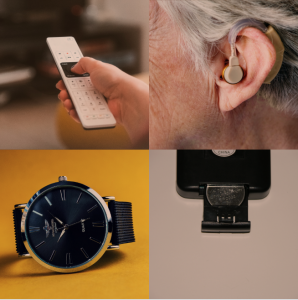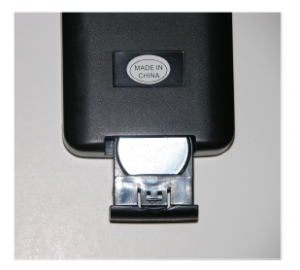Button Batteries & Children1
The Button Battery Hazard
 One of the products that commonly and unfortunately goes overlooked relative to child safety is the button battery. Button batteries are found in a wide variety of common household objects and power small devices that are used throughout the day. They are regularly found in remote controls, thermometers, wrist watches, calculators, and key fobs. While none of these products are marketed solely for children, these products’ button batteries can pose serious dangers to children—whether the batteries are grabbed off a counter or changing table, found on the floor, or removed from a battery compartment.
One of the products that commonly and unfortunately goes overlooked relative to child safety is the button battery. Button batteries are found in a wide variety of common household objects and power small devices that are used throughout the day. They are regularly found in remote controls, thermometers, wrist watches, calculators, and key fobs. While none of these products are marketed solely for children, these products’ button batteries can pose serious dangers to children—whether the batteries are grabbed off a counter or changing table, found on the floor, or removed from a battery compartment.
Because of their shiny exterior and small size, button batteries are attractive and can be easily ingested by children. Once ingested, the batteries pose significant dangers and can even be deadly. While sometimes the battery will pass through the stomach with ease, other times it becomes lodged in the child’s esophagus; this is a dangerous result of ingestion and requires immediate attention.
In the esophagus, once the battery is exposed to bodily fluids, a chemical and electrical reaction occurs, and the battery begins to erode the skin and tissue. In reported cases, symptoms displayed included: irritability, crying, difficulty sleeping, high fever, loss of appetite, and pulling at the ears. Infants and young children who lack fully-developed verbal skills are unable to describe their discomfort or explain the source of it, meaning that the problem can go unnoticed or be mistaken for another common ailment. Serious damage can be done in the time that it takes a child’s parent or caretake to become aware of the ingestion. After just four hours the battery can cause damage to the esophagus and trachea, and two additional hours can lead to severe perforation in this area (Litovitz, 1992, 2010). Such perforation can require reconstructive surgery; if the condition continues to go unnoticed, it can even lead to death.
An Example Situation
The circumstance of a thirteen-month-old was that a lithium button battery was part of a remote control belonging to an AV selector box that allowed his family to use a DVD player and video game console. This child accessed or came into contact with the battery. His curiosity and desire to learn about surroundings somehow led to his ingestion of the remote’s battery. As a developing child, he was exhibiting signs typical of his age, which included high mobility and teething.
An emergency room visit and x-ray confirmed that the button battery was lodged in the child’s esophagus. He had developed a trachea-esophageal fistula, which involves tissue damage and a perforation in the esophageal and tracheal areas. He first needed emergency surgery to remove the button battery; then, he required reconstructive surgery to repair the fistula. Thankfully, the child survived the ordeal, though the incident will cause lasting impacts on his life, including a speech impediment. This family’s experience demonstrates the ease with which button battery ingestion can go unnoticed and have irreversible consequences.
Do U.S. Regulations Apply?
The Consumer Product Safety Commission’s (CPSC) Small Parts Regulation only applies to toys and objects that are solely intended for children under three years old (CPSC, 2001). This condition means that any product entirely marketed for those over three years old, even one that appears to be a “small part”—such as a battery within a remote—is exempt from the regulation. Further, the regulation does not apply to toys or objects “that children under three years of age might have access to simply because of their presence in the household” (CPSC, 2001). Again, this keeps many products with button batteries from coming under the jurisdiction of the CPSC regulation.
In addition, products with button batteries often fail to satisfy the criteria identified in U.S. Code of Federal Regulations 16 CFR 1501: “Method for identifying toys and other articles intended for use by children under 3 years of age which present choking, aspiration, or ingestion hazards because of small parts.” A product is exempted when: “(a) it was not the manufacturer’s intent for the product to be a ‘toy’ or object used by a child under three; (b) it has not been advertised or marketed as a toy or object for a child under three; and (c) it has not been commonly accepted that this is a product for children under three.” (Miller, 2019). For household products like thermometers and key fobs that are button battery-operated, one would conclude that they are exempt from the mandatory requirements of CFR 1501 because young children are not advertised as the primary intended audience of such products.
Addressing the Hazard
The U.S. CPSC has urged battery manufacturers and companies in the electronic industry to develop standards and warnings to combat such injuries and fatalities (CPSC, 2011). An updated ASTM toy safety standard called F-963-11—that is now mandatory—“requires that batteries be inaccessible (e.g., secured in compartments with screws) in all toys intended for children aged <3 years and in all toys using batteries that fit within the small parts tests cylinder and for children aged <12 years” (ASTM, 2016, as cited in Miller, 2019, p. 158). To further protect children from products that remain exempt from the “toy” definition, the CPSC has also released multiple warnings related to button batteries (CSPC, 2011):
- Discard button batteries carefully
- Don’t allow children to play with button batteries, and keep button batteries out of your child’s reach
- Caution hearing aid users to keep hearing aids and batteries out of the reach of children
- Even as an adult, never put button batteries in your mouth for any reason as they are easily swallowed accidentally
- Always check medications before ingesting them; adults have swallowed button batteries mistaken for pills or tablets
- Keep remotes and other electronics out of your child’s reach if the battery compartments do not have a screw to secure them; use tape to help secure the battery compartment
- If a button battery is ingested, immediately seek medical attention. The National Battery Ingestion Hotline is available anytime at (202) 625-3333 (call collect if necessary), or call your poison center at (800) 222-1222
Another good reference is the Children’s Hospital of Philadelphia, which has created a consumer safety video titled “Button Batteries—A Danger to Children” (The Children’s Hospital of Philadelphia, 2016). Further, Safe Kids, founded in 1988, has been joined by battery manufacturers such as Energizer to disseminate information and awareness about the hazard (Safe Kids, 2011).
1 Adapted from Miller, J. M., & Cook, B. T. (2019). This game had a bad ending. In M. S. Wogalter (Ed.), Forensic human factors and ergonomics: Case studies and analyses (149-161). Boca Raton, FL: CRC Press/Taylor & Francis Group.
Adapted by Erinn Promo
References
The Children’s Hospital of Philadelphia. 2016. Button batteries: A danger to children. The Children’s Hospital of Philadelphia. Retrieved from https://www.chop.edu/health-resources/button-batteries-danger-children
Consumer Product Safety Commission (CPSC). (2011). CPSC warns: As button battery use increases, so do battery-related injuries and deaths: Toddlers and seniors most often injured in battery-swallowing incidents. Retrieved from https://www.prnewswire.com/news-releases/cpsc-warns-as-button-battery-use-increases-so-do-battery-related-injuries-and-deaths-118512639.html
Consumer Product Safety Commission (CPSC). (2001). Method for identifying toys and other articles intended for use by children under 3 years of age which present choking, aspiration, or ingestion hazard because of small parts. Retrieved from https://www.gpo.gov/fdsys/pkg/CFR-2016-title16-vol2/xml/CFR-2016-title16-vol2-part1501.xml
Litovitz, T.L. (1992). Ingestion of cylindrical and button batteries: An analysis of 2382 cases. Pediatrics, 89(4), 747-757.
Litovitz, T.L. (2010). Emerging battery-ingestion hazard: Clinical implications. American Academy of Pediatrics, 125(6), 1168-1177. doi: 10.1542/peds.2009-3037
Miller, J. M., & Cook, B. T. (2019). This game had a bad ending. In M. S. Wogalter (Ed.), Forensic human factors and ergonomics: Case studies and analyses (149-161). Boca Raton, FL: CRC Press/Taylor & Francis Group.
Safe Kids. (2011, September 14). Safe kids USA and Energizer join together to prevent button battery ingestion. Retrieved from https//:www.youtube.com/watch?time_continue=4&v=GfgzheWXQ1Y
